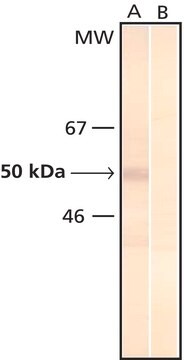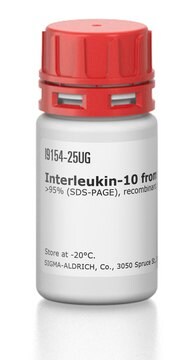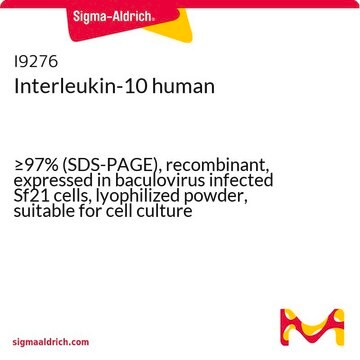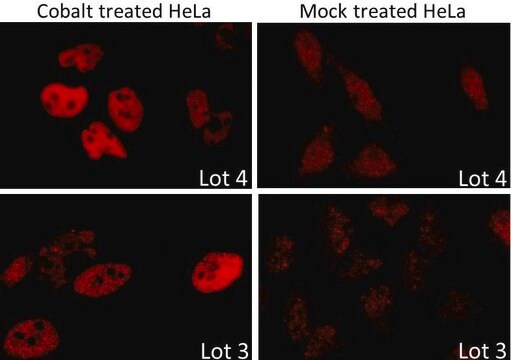MAB1004
Anti-Interleukin-6 Antibody, clone 4B6
clone 4B6, Chemicon®, from mouse
Synonym(s):
IL-6
Sign Into View Organizational & Contract Pricing
All Photos(1)
About This Item
UNSPSC Code:
12352203
eCl@ss:
32160702
NACRES:
NA.41
Recommended Products
biological source
mouse
Quality Level
antibody form
purified immunoglobulin
antibody product type
primary antibodies
clone
4B6, monoclonal
species reactivity
sheep
manufacturer/tradename
Chemicon®
technique(s)
ELISA: suitable
isotype
IgG1
NCBI accession no.
UniProt accession no.
shipped in
dry ice
target post-translational modification
unmodified
Gene Information
sheep ... Il6(443406)
Specificity
Reacts with ovine IL-6. No reactivity detected to recombinant ovine IL-1beta, IL-8, MCP or TNFalpha.
SPECIES REACTIVITY:
The antibody is likely to react with caprine (goat) IL-6.
SPECIES REACTIVITY:
The antibody is likely to react with caprine (goat) IL-6.
Immunogen
Recombinant ovine IL-6
Application
Capture antibody in ELISA. Recommended coating concentration 5 μg/mL. See suggested protocol.
Optimal working dilutions must be determined by the end user.
Suggested ELISA Protocol For Ovine IL-6
1. Coat high capacity microtitre wells (e.g. Nunc maxisorp) with monoclonal anti-IL-6 antibody (Chemicon Catalog Number MAB1004) at a concentration of 5 μg/mL in 0.1 M carbonate buffer pH 9.6 overnight at 4ºC.
2. Wash wells 3 x with PBS + 0.05% Tween 20 (PBST).
3. Add samples to wells. Incubate at room temperature in a humidified box for 1 hour. Wash 3 x with PBST.
4. Dilute rabbit anti-IL-6 (Chemicon Catalog Number AB1839) 1:500 in PBST and add 100 μL to wells. Incubate at room temperature for 30 minutes. Wash 3 x with PBST.
5. Dilute anti-rabbit IgG-HRP to appropriate level in PBST and add 100 μL to wells. Incubate 30 minutes at room temperature. Wash 3 x with PBST.
6. Add 100 μL of TMB chromagen to each well. Incubate for 5-10 minutes and stop reaction with 50 μL of 2M sulfuric acid.
Notes:
The anti-rabbit IgG HRP must be adsorbed against mouse immunoglobulin, and should be checked for non-reactivity with coated plates.
Non-specific binding may be reduced by addition of protein such as skim milk powder to the diluents.
Assay sensitivity may be altered by adjusting incubation times and reagent concentrations.
Optimal working dilutions must be determined by the end user.
Suggested ELISA Protocol For Ovine IL-6
1. Coat high capacity microtitre wells (e.g. Nunc maxisorp) with monoclonal anti-IL-6 antibody (Chemicon Catalog Number MAB1004) at a concentration of 5 μg/mL in 0.1 M carbonate buffer pH 9.6 overnight at 4ºC.
2. Wash wells 3 x with PBS + 0.05% Tween 20 (PBST).
3. Add samples to wells. Incubate at room temperature in a humidified box for 1 hour. Wash 3 x with PBST.
4. Dilute rabbit anti-IL-6 (Chemicon Catalog Number AB1839) 1:500 in PBST and add 100 μL to wells. Incubate at room temperature for 30 minutes. Wash 3 x with PBST.
5. Dilute anti-rabbit IgG-HRP to appropriate level in PBST and add 100 μL to wells. Incubate 30 minutes at room temperature. Wash 3 x with PBST.
6. Add 100 μL of TMB chromagen to each well. Incubate for 5-10 minutes and stop reaction with 50 μL of 2M sulfuric acid.
Notes:
The anti-rabbit IgG HRP must be adsorbed against mouse immunoglobulin, and should be checked for non-reactivity with coated plates.
Non-specific binding may be reduced by addition of protein such as skim milk powder to the diluents.
Assay sensitivity may be altered by adjusting incubation times and reagent concentrations.
Research Category
Inflammation & Immunology
Inflammation & Immunology
Research Sub Category
Cytokines & Cytokine Receptors
Cytokines & Cytokine Receptors
This Anti-Interleukin-6 Antibody, clone 4B6 is validated for use in ELISA for the detection of Interleukin-6.
Physical form
Format: Purified
Liquid in PBS containing 0.1% sodium azide.
Storage and Stability
Maintain at -20°C in undiluted aliquots for up to 12 months. Avoid repeated freeze/thaw cycles.
Other Notes
Concentration: Please refer to the Certificate of Analysis for the lot-specific concentration.
Legal Information
CHEMICON is a registered trademark of Merck KGaA, Darmstadt, Germany
Disclaimer
Unless otherwise stated in our catalog or other company documentation accompanying the product(s), our products are intended for research use only and are not to be used for any other purpose, which includes but is not limited to, unauthorized commercial uses, in vitro diagnostic uses, ex vivo or in vivo therapeutic uses or any type of consumption or application to humans or animals.
Not finding the right product?
Try our Product Selector Tool.
Storage Class Code
10 - Combustible liquids
WGK
WGK 2
Flash Point(F)
Not applicable
Flash Point(C)
Not applicable
Certificates of Analysis (COA)
Search for Certificates of Analysis (COA) by entering the products Lot/Batch Number. Lot and Batch Numbers can be found on a product’s label following the words ‘Lot’ or ‘Batch’.
Already Own This Product?
Find documentation for the products that you have recently purchased in the Document Library.
Tate Gisslen et al.
Innate immunity, 20(2), 214-224 (2013-06-12)
Histologic chorioamnionitis, frequently associated with preterm births and adverse outcomes, results in prolonged exposure of preterm fetuses to infectious agents and pro-inflammatory mediators, such as LPS. Endotoxin tolerance-type effects were demonstrated in fetal sheep following repetitive systemic or intra-amniotic (i.a.)
Gunlawadee Maneenil et al.
PloS one, 10(3), e0119281-e0119281 (2015-03-21)
A fetal inflammatory response (FIR) in sheep can be induced by intraamniotic or selective exposure of the fetal lung or gut to lipopolysaccharide (LPS). The oral, nasal, and pharyngeal cavities (ONP) contain lymphoid tissue and epithelium that are in contact
Modulation of lipopolysaccharide-induced chorioamnionitis by Ureaplasma parvum in sheep.
Snyder, CC; Wolfe, KB; Gisslen, T; Knox, CL; Kemp, MW; Kramer, BW; Newnham, JP; Jobe et al.
American Journal of Obstetrics and Gynecology null
Selective exposure of the fetal lung and skin/amnion (but not gastro-intestinal tract) to LPS elicits acute systemic inflammation in fetal sheep.
Kemp, MW; Kannan, PS; Saito, M; Newnham, JP; Cox, T; Jobe, AH; Kramer, BW; Kallapur, SG
Testing null
Daan R M G Ophelders et al.
Journal of neuroinflammation, 13, 29-29 (2016-02-05)
Intra-amniotic Candida albicans (C. Albicans) infection is associated with preterm birth and high morbidity and mortality rates. Survivors are prone to adverse neurodevelopmental outcomes. The mechanisms leading to these adverse neonatal brain outcomes remain largely unknown. To better understand the
Our team of scientists has experience in all areas of research including Life Science, Material Science, Chemical Synthesis, Chromatography, Analytical and many others.
Contact Technical Service








